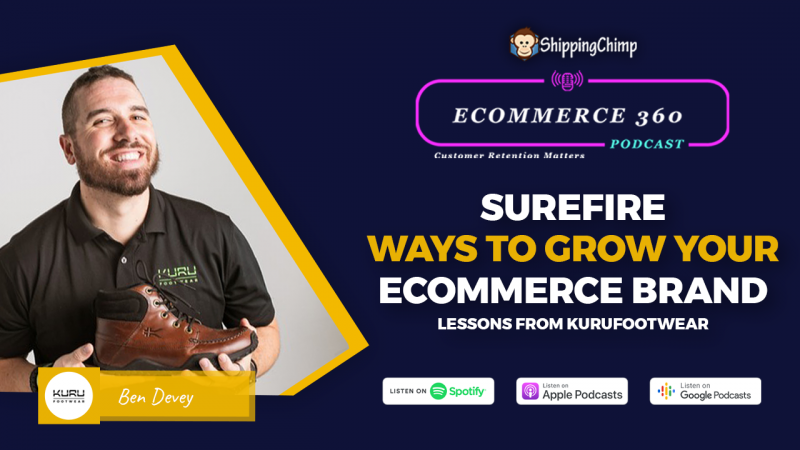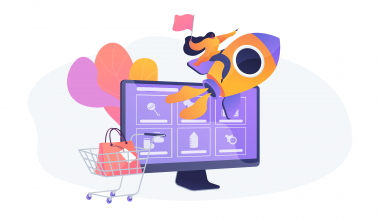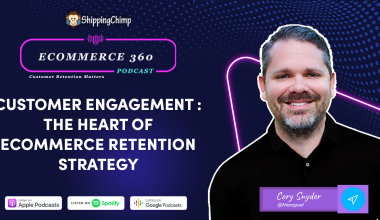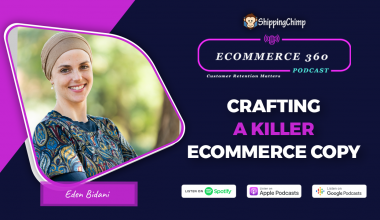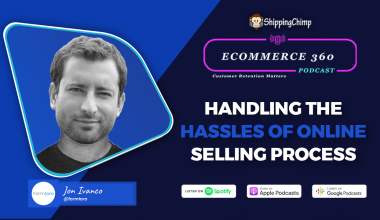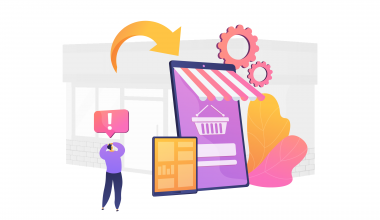We discuss in this episode how Kuru footwear makes a strong brand impression with its impeccable customer service. Shoppers are increasingly paying attention to brands that care and have a social responsibility. Watch this episode to get the basics right for your eCommerce store.
In this episode we discuss:
- What is the one metric that you consider as a NorthStar metric at Kuru footwear?
- Steps to overcome shipment and fulfillment challenges from a customer experience perspective
- How to pacify angry customers or anxious customers?
- Strategies to handle returns and exchanges
- What are the trends for the future of e-commerce?
Revathi: Hey folks, welcome to ecommerce 360. We have Ben Devey today director of customer and employee experience at Kuru footwear. Kuru footwear is a DDC shoe company on a mission to eliminate footprint. Hey. Ben. How you doing? Welcome to ecommerce. 360.
Ben: Yeah, thanks. Thanks for having me.
Revathi: Hey, Ben. So, can you take us back to the time, when it all started? And how did you embark on this journey with Kuru footwear?
Yeah, and this is my personal journey or the company?
Revathi: It’s like mesh together. Like, how did you start your personal journey? And then how did you end up at Kuru footwear and what are your goals right now?
Ben: So, for me, you know, ever since I was 16, I’ve had call center jobs. You know, in general, in Salt Lake City, there’s just a lot of call centers. So, I moved around, and then I got promoted up through leadership positions at other companies. And I’m one of my colleagues. When I was at DirecTV, we were sales managers at different sites here in Utah. She had actually applied and accepted the position for Kuru footwear, and then had a death in the family. So, she had to withdraw. The CEO at the time, Brett asked her who, who else she knew in the space, that would be a good fit. And she referred to me.
So, I was I actually got a call from Brett, our CEO, one late Friday night, talking to me about the opportunity. And, you know, I’ve never heard about Kuru footwear before. So, I checked them out and came in and thought it would just be a really cool experience when I first started. I mean, we were small enough that like our CEO, Brett has still had a line where if our customer service calls overflowed, he was still taking phone calls.
We had people in the warehouse, taking customer service calls. I mean, it was, it was really small when I first started. And so, that was one of the cool opportunities for me was coming in and being able to help them build the customer experience from scratch. And Brett our CEO, shared his vision with me, and he gave me a lot of autonomy on in reference of like, okay, here’s my vision, can you for our customer experience, we got on the same page, and then like, Hey, can you go and execute that? And then five years later, I’m still loving it.
Revathi: That’s great. That’s wonderful. So, you know, five years back? And, you know, fast forward five years now, do you see that, you know, your goals have changed, your metrics have changed. What sort of metrics should eCommerce businesses go after? As far as customer experience is concerned?
What is the one metric that you consider as a NorthStar metric at Kuru footwear?
Ben: I would talk about a couple. I mean, you know, like, C sat, is still one of the best metrics for understanding at least how your customer support team is performing once people get to you.
But one of our key strategies is creating a world-class, anticipatory experience.
And part of that is, we’re trying to engineer our process in customer journey in a way that, you know, we’re solving customers’ needs before they knew that they even had them. And still for sure a work in progress.
But one of the metrics that I didn’t really have when we first started that we focus on now is our customer effort score. And so just trying to understand, like, how easy we’re making it for our customer, and there’s so much effort on our end right now on how are we making it easy for our customer? How are we reducing customer effort, intention, and what different parts of the customer journey our customers reporting frustration for where they’re having to put more effort into it, and how we can eliminate those things.
And so, it’s been really great because, you know, I don’t focus necessarily on, you know, our channel mix, like, I’m trying to change our channel mix. So, we’re getting fewer emails, and we want to push them to chat. For me, I don’t care how they’re contacting us. I mean, we want to create an omnichannel experience, where, you know, someone chats and then calls in an agent who can immediately have all the context and that information in an instant. So, a customer never has to repeat themselves.
And we have an ongoing history and a relationship with that customer but I’m more care why did that customer have to contact us in the first place? Like what was it that made them channel to switch from. Hey, I was trying to do this online on my own to now and have the contact or customer support team. But we focus a lot on eliminating that.
Revathi: Okay, that’s interesting when you talk about making the customer journey as seamless as possible. I’m constantly reminded about shipping and fulfillment, you know, shipping and fulfillment is almost a nightmare for eCommerce businesses.
What steps do you think you as Kuru footwear are taking to overcome shipment and fulfillment challenges from a customer experience perspective?
Ben: Yeah, I mean, a lot of different things. I mean, some of it includes like our processing around like, how do we handle when customers are reporting loss or stolen packages? We’ve been very fortunate that our, you know, our percentage of conversations related to when customers are reporting loss or damaged packages is extremely well, but then, you know, part of that strategy of making it easy and anticipatory experiences. Like, what’s the process when someone reports? How can we make that so we see now that this isn’t going to be a deterrent from doing business with us in the future? You know, we don’t require signatures on our package.
And so just evaluating that, evaluating shippers too. I mean, we’ve had, as a company, we have made a decision to go away from a shipper who was less expensive, but was causing too many customer experience issues and opted to pay more so that we could provide a better shipping experience own that it’s going to pay off in the long run. So, we’ve had to remove or move away from different shippers that we were just getting too many reports of like issues with, you know, what I mentioned the processes on what we do as well.
And then also just trying to be very proactive with different shipping issues and concerns, you know, like exception, you know, if we’re already getting a report from our shipper about which packages are being delayed, you know, instead of waiting for the customer to trigger those responses, like what processes do we have to reach out proactively to those customers to let them know?
And so I think it’s a combination of everything, just with the focus of like, how can we make this as easy as possible for our customer.
Revathi: So earlier, when you mentioned shipping experience, right? closely aligned with the shipping experiences, the post-purchase experience, or related queries or auto-generated related queries make up 40% of customer support.
How do you at Kuru footwear pacify angry customers or avoid, you know, getting yourself into a pickle situation with customers, especially related to order deliveries?
Ben: In reference to like, once the inquiries come in like we have a, you know, we really allow our support agents to be themselves, but we have a quality system in place to ensure that we’re having consistent brand experience throughout. And one of the most important things about that is how we emphasize and acknowledge with our customers.
So, making sure that they know that we’re listening, that we understand where they’re coming from. That’s really the most important thing in all of our interactions, especially when you’re dealing with those scenarios. Because if someone’s already asking where’s my order, you’ve already felt them in some way. Or their expectation, whether that be they never got their tracking confirmation, or they do have the tracking, but it’s not showing any movement, whatever the cases, in so just acknowledging and empathizing upfront, and then from there, identifying and what do we need to do to get this taken care of, with as little effort from the customer?
And then, of course, like, from our perspective of if this is something that we can control? How are we, you know, what are we going to change to ensure that these situations don’t continue to happen? You know, obviously, with some stuff, you know, whether you’re using UPS, FedEx, like whomever, right, you’re always going to run into some issues, you know, but at the same time, you know, how you handle the customer situation, how you emphasize, acknowledge, like, what’s the processes that you have in place to just really make it as easy as possible on the customer, I think is the key part.
Revathi: Absolutely. And how do you handle returns and exchanges?
Earlier you mentioned that you also have to handle returns and exchanges are part of the customer experience. How do you go about handling those cases?
Ben: I mean, returns and exchanges, that’s the bulk of why our customers interact with our customer support group. The one point of contact we’re trying to eliminate is when customers have a hard time understanding how did you like to take advantage of the return exchange process, we offer free returns and exchanges up to 45 days from the date of order in the domestic US.
And we still offer internationally, we offer returns and exchanges, we just don’t cover the return shipping in those cases. And so, for us, it’s, you know, we’re still trying to do a better job of identifying when people don’t understand how to get into that process. And that’s why they’re contacting us. And, you know, that’s part of the making it easy and anticipatory, of trying to help them, you know, make that an easier process. You know, and we have a lot of returns exchanges, where it’s just in reference of, you know, we’re all about solving for foot pain. And so, you get a lot of different people with a lot of different foot problems. And so, we try to be as empathetic as possible to the foot pain that they’re going through. And then we try to help, you know, our agents are called Kuru-gurus.
And we call them that, because we really tried to be as knowledgeable as possible and reference of like, okay, so if you’re experiencing more in serum, you have fallen arches, and you’re having plantar fasciitis, based off our data and previous customer feedback, we think you’re going to have the most success with this style.
The cool thing is, our marketing and eCommerce team has already done a great job of creating a customer journey on the site to help people identify those styles in advance, but, you know, sometimes, we have a lot of just sizing questions like hey, and sometimes you’ll have customers that rattle off five different foot problems in the not so which one is going to be best for me. So that’s where we jump in a lot, as well as setting expectations. We have, you know, we say we have a break-in period with our footwear, and we have patented support built into our foot our footwear itself. And no one’s used to this. And so you get a lot of people were when they were our shoes for the first time, their body’s like adapting to the support. And sometimes they go through, you know, like my first pair of Kuru’s, I actually got really bad lower back pain for like the first three days. And that’s just while it was realigning my body.
And so, we have a lot of conversations where it’s about, like, hey, how long have you worn them? Hey, if you’ve only worn them for an hour, keep wearing given it time, if the fit is right just give it more time, especially if someone’s dealing with a foot injury, you know. And one of the things that we did is we kept getting that question so often that we actually created an email that goes out to the customer two days after purchase, explain the break-in period in detail. But yeah, and then, you know, and then from there, we just help the customers as much as we can with the return exchange process, whether they, whether they are deciding, like. Hey, I’m going to return it for a refund, or I want to exchange it for a different size, or maybe even try another style.
Revathi: That’s, that’s interesting how you’re going through the process of educating your customers, while your package or while their package is still out for delivery. That’s very interesting. So, talking about empathy, I came across Kuru cares as an initiative that has been on for quite some time now.
Would you say that you know, shoppers are increasingly opting for brands that are more socially responsible?
Ben: Yeah, I mean, I think so. I mean, I think in general people want to just see more of a trend of people with the value set system, and they want to do business with other companies that they feel have that same value system. And so, I think that for sure, is growing in importance when it comes to someone making a decision on who they’re going to select, to solve whatever job to be done. They have. And so, you know, and our CEO, Brett, like, that’s very much part of like, who he is. And there’s just a lot of initiatives that he does. So, he’s just always been a great example of that. But yeah, I think it for sure it’s growing in importance.
Revathi: That’s amazing. That’s a brilliant initiative. So as a final question, as a wrap up, how do you envision the future of ecommerce customer service is going to be like what’s going to go boom and going to go fast.
What are the trends that you envision for the future of e-commerce?
Ben: Yeah, I mean, I think the great question. I mean, the, you know, the CRM platform that we use, that we partnered with that we felt really strong was a good match for, like our values. And they talked about radically personable customer experiences. I think people more and more, especially if you do repeat business with the company, I think we all want to understand that they know who we are.
And so, I think, you know, as we continue to engineer customer journeys, and experiences, where it’s so easy to identify who the customer is, and honestly, I think like, with how busy and hectic everyone’s lives are getting, and just getting busier and busier, I think those companies that excel at making incredibly easy experiences are going to gain the most customer loyalty in the long run. So, I think that companies that can really nail the nail on the head, especially from an e commerce perspective of like they were so incredibly easy to do business with, they’re the ones that are going to start coming out more and more ahead.
And, and again, that’s where our focus is, I mean, apart from just creating a great customer journey where we’re educating but it’s all about that customer effort, like, you know, what are the friction points? And so that’s where I see it going is how anticipatory Can we really be? And then how personalized Can we make it where people that are coming back to us, know that we know who they are. And that’s very evident when we interact with them.
Revathi: That’s great. So, make it personal, make it relatable, make it easy. So that’s great. Let’s call this a wrap. Thank you so much, Ben for having kind of coming on this podcast and unpacking a lot of insights about the customer experience. To mention, we take customer experience for ecommerce stores very seriously and we think that’s going to, you know, kind of pay the future for retail. Thank you so much, Ben for coming.
